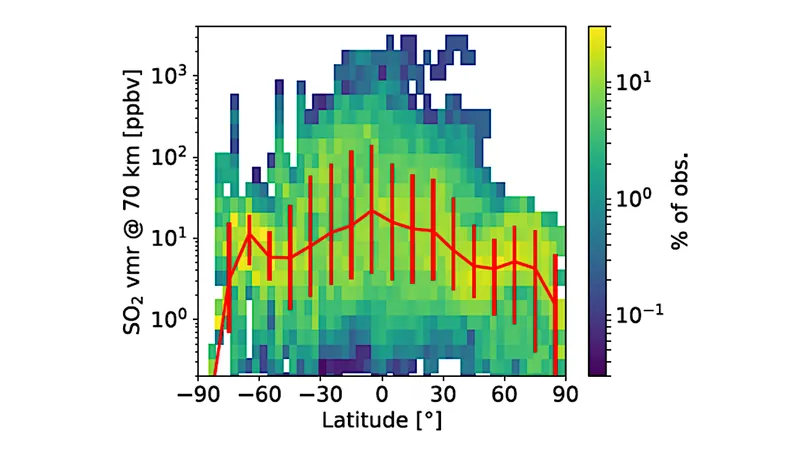
Unveiling the Secrets of Sulfur on Venus: A Deep Dive into Its Atmosphere, Surface, and Geological History
2024-09-25
Author: Siti
Sulfur Abundance and Composition
Instrumental data has been employed to assess sulfur's concentration and its various forms within both the atmosphere and the crust of Venus. Most of this information has been gathered through sophisticated telescopic and spacecraft observations, including flybys and orbital missions, along with limited in situ measurements from landing probes.
Atmospheric Behavior of Sulfur
Notably, sulfur dioxide (SO2) stands out as the principal trace gas in Venus's middle and lower atmosphere. Through photochemical processes, CO2 disintegrates above the clouds, yielding CO and O, which subsequently lead to the oxidation of SO2 into sulfuric acid (H2SO4). This process maintains the dense, sulfur-rich global cloud cover. Complex interactions between SO2 and surface materials like basaltic glasses contribute to the formation of sulfates, indicating up to 2% sulfur content in surface samples.
Chemical Interactions and Geological Evolution
The fate of sulfur is particularly fascinating during the planet's formative processes. Sulfur's role in volcanic activity, gas-solid interactions, and the potential past presence of liquid water must be further dissected. The presence of carbonyl sulfide (OCS), the most abundant reduced sulfur gas, is notably produced from interactions involving CO and elemental sulfur and is likely altered through mineralizing processes.
Future Exploration and Research Directions
The exploration of Venus continues to unveil more questions than answers. The upcoming missions—DAVINCI, VERITAS, and EnVision—are set to probe deep into the atmospheric and surface compositions of Venus, aiming to unravel the intricate processes where sulfur plays a crucial role. Investigating sulfur-bearing species and their isotopic compositions will be imperative in deciphering the planet's atmospheric dynamics and surface history.
The Impact of Cosmic and Atmospheric Sources
While volcanic activity has predominantly contributed to the current atmospheric sulfur levels, other sources, including cosmic dust, may have enriched the atmosphere further, resulting in notable sulfur gas ratios. The complex interplay between exogenic and endogenic processes could have shaped the current geological landscape, presenting morphologies consistent with both water-rich and arid conditions.
Conclusion
In summary, the study of sulfur on Venus offers a tantalizing glimpse into the atmospheric and geological intricacies of our sister planet. The interplay between volcanic activity, atmospheric chemistry, and surface interactions continues to be a captivating area of research, with upcoming missions promising to illuminate more of Venus's enigmatic characteristics. Prepare for a thrilling journey as we unlock the mysteries of the sulfur cycle on Venus—stay tuned!





 Brasil (PT)
Brasil (PT)
 Canada (EN)
Canada (EN)
 Chile (ES)
Chile (ES)
 Česko (CS)
Česko (CS)
 대한민국 (KO)
대한민국 (KO)
 España (ES)
España (ES)
 France (FR)
France (FR)
 Hong Kong (EN)
Hong Kong (EN)
 Italia (IT)
Italia (IT)
 日本 (JA)
日本 (JA)
 Magyarország (HU)
Magyarország (HU)
 Norge (NO)
Norge (NO)
 Polska (PL)
Polska (PL)
 Schweiz (DE)
Schweiz (DE)
 Singapore (EN)
Singapore (EN)
 Sverige (SV)
Sverige (SV)
 Suomi (FI)
Suomi (FI)
 Türkiye (TR)
Türkiye (TR)
 الإمارات العربية المتحدة (AR)
الإمارات العربية المتحدة (AR)